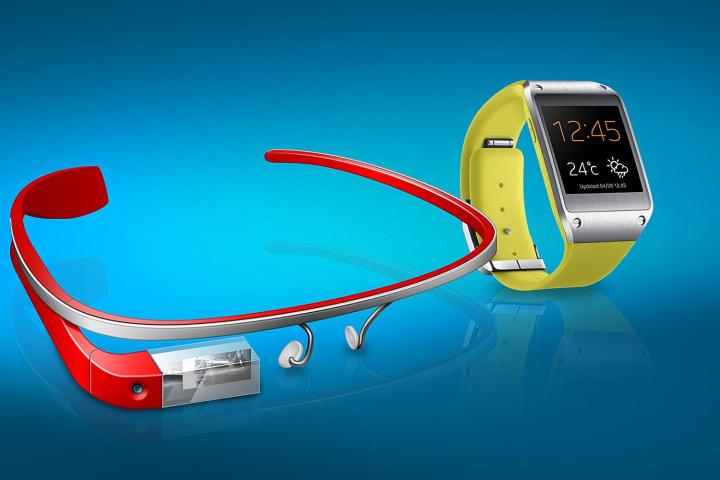
Yesterday’s unveiling of Samsung’s Gear smartwatch has some hyperventilating about how this oft-ballyhooed form factor has finally arrived. But as we watched the event unfold, and some of us even got our mitts on it, we couldn’t help but think that, stripped of the whole band and face, the Gear didn’t strike us as that different from another oft-ballyhooed form factor: Google Glass. What’s more, Glass is superior in most every way, and it’s not even out of beta.
Let’s see how these two devices stack up in some completely fair categories we’ve arbitrarily concocted …
Laziness
Gear has rightly been described described as a slave to the Galaxy Note 3.0; it serves exclusively to communicate information on the phablet to the wrist so you don’t have to go through all the onerous motions of pulling your giant phone out from your bag (or the massive pockets you had custom tailored to fit it). Because, really, using your arms in such a way is exhausting. But what about that wrist-born screen? It’s not showing itself to you, now is it? If you want to know what’s going on on your Note you have to … that’s right! … Lift your arm!
Glass is the ultimate in convenience. There’s no rolling back of the sleeve, no exhausting pivot of the elbow and angling of the neck. Information is delivered directly to your face and requires moving nothing but your eyeballs. Granted, eyeball moving can be tiring, but nowhere near as tiring as arm movements.
Winner: Google Glass
Skin and eye health

Winner: Google Glass
Social situations
If looking old isn’t bad enough, there’s the social implications of screen location. Glass takes a bit of getting used to, but once mastered you can literally scan your message feeds without anyone around you thinking you’re doing anything beyond adjusting your glasses to see them better. Gear requires you to look at your watch in the middle of a conversation.
So. Notifications and information delivery = better. Chances of being called an ass at the dinner table = lessened.
Winner: Google Glass
Talking on the phone

This is simple biology. Your mouth is closer to your eyes than it is to your wrist. Yes, you can lift Gear to your mouth, but it’s less convenient and arguably more ridiculous than talking into thin air. And unless you’re one of these kids, you probably don’t want to spend your time talking like Dick Tracy.
Winner: Google Glass
Video recording
We’ve seen skydivers, marriage proposals, and even surgery shot with Glass, most of which are only possible because you can still use your arms and hands while doing so. Glasshole Robert Scoble says Google’s camera takes less than one second to activate, which means you won’t miss those special moments marketing folk are always telling us about.
Compare that with Gear, where one of your hands will always be out of commission while recording, and you’ll need to master the art of aiming and focusing a lens that’s at a 90-degree angle to the viewfinder. As opposed to, you know, just looking at something.
Winner: Google Glass
Device support
Gear doesn’t just need to be connected to a phone to work; it has to be connected to a Note 3.0 or 10.1 2014 edition. Glass, on the other hand, is compatible with most Android devices and iPhone/iPad, too. We get that Samsung has made a strategic move to bolster its ecosystem of device. We also don’t know anyone clambering for a Galaxy Note 3.0 or the new 10.1.
Winner: Google Glass

If we had to wear one of these…
We don’t really want to wear either of these devices right now, but if we had to choose, the Google Glass would squeak ahead by a nose. Both of these devices are highly noticeable, and not in a good way. Gear clocks in at 11mm thick and 73 grams, which is totally acceptable for a new TAG Heuer but less so for what will be seen by most of the populace as the world’s largest calculator watch. But at least it doesn’t make you look like a Borg wannabe, like Glass. Still, if we had to pick one, we’d rather go with Glass. At least it would help us earn more geek cred, and hey, maybe we could use it to pick up girls.
Winner: Google Glass
And the winner is Google Glass (by a landslide)
Final Score: Google Glass 7, Galaxy Gear 0
If you’re going to use a second device to augment your smartphone, surely you’ll want it to be as convenient, as unobtrusive, and as future-proofed as possible. Google Glass is – even in its current beta state – exciting, technically superior, and a better everyday companion to your smartphone than Gear.
Gear may have won the current news cycle, but the march toward hardware innovation is a marathon, not a sprint, and Google Glass is miles ahead of the upstart king of the smart watch.
Editors' Recommendations
- Samsung Galaxy Watch 6 vs. Galaxy Watch 6 Classic: which should you buy?
- Samsung Galaxy S24 vs. Google Pixel 8: which Android phone is best?
- Google Pixel 8 Pro vs. Samsung Galaxy S23 UItra: don’t buy the wrong one
- Samsung Galaxy Z Fold 5 vs. Google Pixel Fold: $1,800 foldable showdown
- Google Pixel Fold vs. Galaxy Z Fold 4: which one is worth $1,800?


